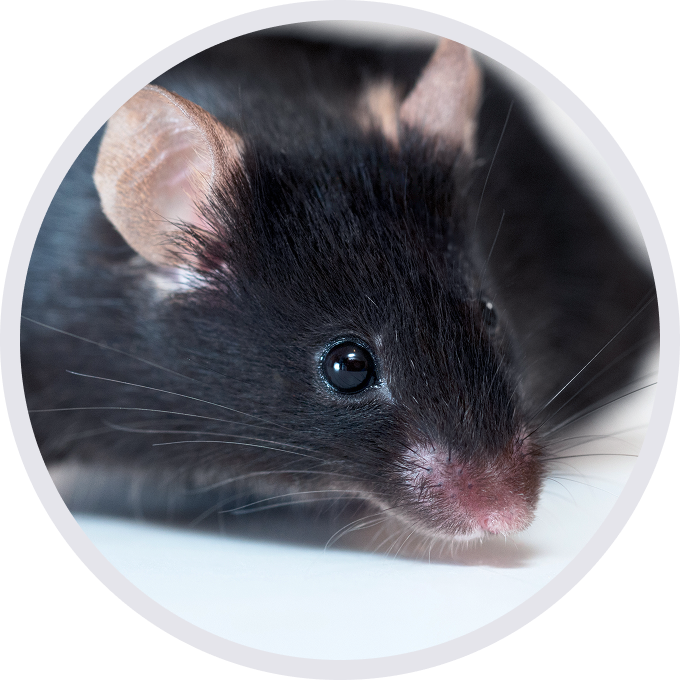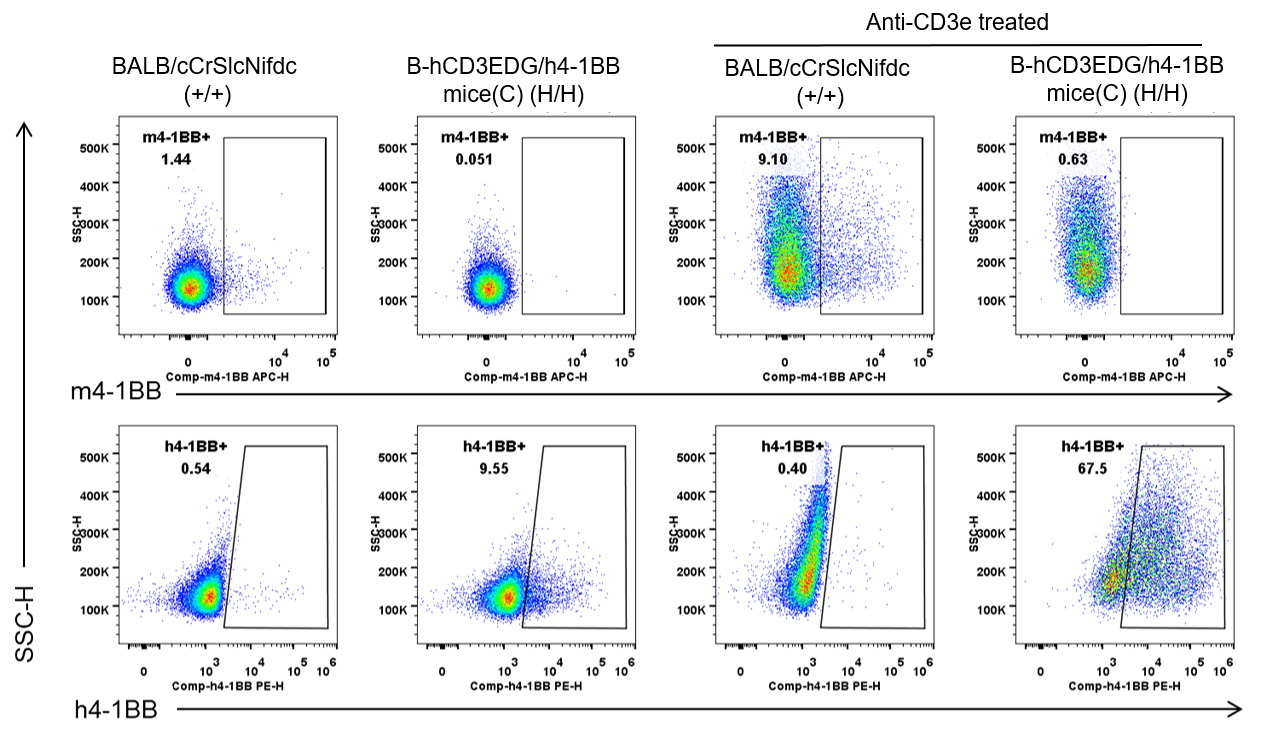
C.B6-Cd3etm1(CD3E)Bcgen Cd3dtm1(CD3D)Bcgen Cd3gtm1(CD3G)Bcgen Tnfrsf9tm1(TNFRSF9)Bcgen/Bcgen • 113254

| Product name | B-hCD3EDG/h4-1BB mice(C) |
|---|---|
| Catalog number | 113254 |
| Strain name | C.B6-Cd3etm1(CD3E)Bcgen Cd3dtm1(CD3D)Bcgen Cd3gtm1(CD3G)Bcgen Tnfrsf9tm1(TNFRSF9)Bcgen/Bcgen |
| Strain background | C57BL/6; BALB/cCrSlcNifdc |
| NCBI gene ID | 916,915,917,3604 (Human) |
| Aliases | T3E; TCRE; IMD18; CD3epsilon; T3D; IMD19; CD3DELTA; CD3-DELTA; T3G; IMD17; CD3GAMMA; CD3-GAMMA; ILA; 4-1BB; CD137; CDw137; IMD109 |
Gene targeting strategy for B-hCD3EDG/h4-1BB mice(C). Chimeric human CD3EDG were expressed, while mouse Cd3edg were knocked out in B-hCD3EDG/h4-1BB mice(C). The exons 2-7 of the mouse Tnfrsf9 gene, which encode the extracellular domain, were replaced by human counterparts in B-hCD3EDG/h4-1BB mice(C). The genomic region of mouse Tnfrsf9 gene that encodes transmembrane domain and cytoplasmic portion were retained. The promoter, 5’UTR and 3’UTR region of the mouse gene were also retained. The chimeric 4-1BB expression was driven by endogenous mouse Tnfrsf9 promoter, while mouse Tnfrsf9 gene transcription and translation will be disrupted.

Strain specific analysis of CD3E, D, G mRNA expression in wild-type BALB/cCrSlcNifdc mice and B-hCD3EDG/h4-1BB mice(C) by RT-PCR. Spleen RNA were isolated from wild-type BALB/cCrSlcNifdc mice (+/+) and homozygous B-hCD3EDG/h4-1BB mice(C) (H/H), then cDNA libraries were synthesized by reverse transcription, followed by PCR with mouse or human CD3E, D, G primers. Mouse Cd3e, d, g mRNA was only detectable in wild-type mice. Human CD3E, D, G mRNA was exclusively detectable in homozygous B-hCD3EDG/h4-1BB mice(C) but not in wild-type mice.

Strain specific analysis of 4-1BB mRNA expression in wild-type BALB/cCrSlcNifdc mice and B-hCD3EDG/h4-1BB mice(C) by RT-PCR. Spleen RNA were isolated from wild-type BALB/cCrSlcNifdc mice (+/+) and homozygous B-hCD3EDG/h4-1BB mice(C) (H/H), then cDNA libraries were synthesized by reverse transcription, followed by PCR with mouse or human 4-1BB primers. Mouse 4-1bb mRNA was only detectable in wild-type mice. Human 4-1BB mRNA was exclusively detectable in homozygous B-hCD3EDG/h4-1BB mice(C) but not in wild-type mice.

Strain specific CD3E expression analysis in wild-type BALB/cCrSlcNifdc mice and homozygous humanized B-hCD3EDG/h4-1BB mice(C) by flow cytometry. Spleen T cells were collected from wild-type BALB/cCrSlcNifdc mice (+/+) and homozygous B-hCD3EDG/h4-1BB mice(C) (H/H) (n=3, male, 9-week-old). Protein expression was analyzed with anti-mouse CD3E antibody (Biolegend, 100312) and anti-human CD3E antibody (Biolegend, 562426) by flow cytometry. Mouse CD3E was only detectable in wild-type BALB/cCrSlcNifdc mice. Human CD3E was exclusively detectable in homozygous B-hCD3EDG/h4-1BB mice(C), but not in wild-type BALB/cCrSlcNifdc mice.

Strain specific 4-1BB expression analysis in wild-type BALB/cCrSlcNifdc mice and homozygous humanized B-hCD3EDG/h4-1BB mice(C) by flow cytometry. Spleen T cells were collected from wild-type BALB/cCrSlcNifdc mice (+/+) and homozygous B-hCD3EDG/h4-1BB mice(C) (H/H), stimulated with anti-CD3ε in vivo (15 μg/mice for 24 hours, i.p.; BioXcell, BE0001-2, BioXcell, BE0001-1). Protein expression was analyzed with anti-mouse 4-1BB antibody (Biolegend, 106110) and anti-human 4-1BB antibody (Biolegend, 309804) by flow cytometry. Mouse 4-1BB was only detectable in wild-type BALB/cCrSlcNifdc mice. Human 4-1BB was exclusively detectable in homozygous B-hCD3EDG/h4-1BB mice(C), but not in wild-type BALB/cCrSlcNifdc mice.

Strain specific 4-1BB expression analysis in wild-type BALB/cCrSlcNifdc mice and homozygous humanized B-hCD3EDG/h4-1BB mice(C) by flow cytometry. Spleen CD4+ T cells were collected from wild-type BALB/cCrSlcNifdc mice (+/+) and homozygous B-hCD3EDG/h4-1BB mice(C) (H/H), stimulated with anti-CD3ε in vivo (15 μg/mice for 24 hours, i.p.; BioXcell, BE0001-2, BioXcell, BE0001-1). Protein expression was analyzed with anti-mouse 4-1BB antibody (Biolegend, 106110) and anti-human 4-1BB antibody (Biolegend, 309804) by flow cytometry. Mouse 4-1BB was only detectable in wild-type BALB/cCrSlcNifdc mice. Human 4-1BB was exclusively detectable in homozygous B-hCD3EDG/h4-1BB mice(C), but not in wild-type BALB/cCrSlcNifdc mice.

Strain specific 4-1BB expression analysis in wild-type BALB/cCrSlcNifdc mice and homozygous humanized B-hCD3EDG/h4-1BB mice(C) by flow cytometry. Spleen CD8+ T cells were collected from wild-type BALB/cCrSlcNifdc mice (+/+) and homozygous B-hCD3EDG/h4-1BB mice(C) (H/H), stimulated with anti-CD3ε in vivo (15 μg/mice for 24 hours, i.p.; BioXcell, BE0001-2, BioXcell, BE0001-1). Protein expression was analyzed with anti-mouse 4-1BB antibody (Biolegend, 106110) and anti-human 4-1BB antibody (Biolegend, 309804) by flow cytometry. Mouse 4-1BB was only detectable in wild-type BALB/cCrSlcNifdc mice. Human 4-1BB was exclusively detectable in homozygous B-hCD3EDG/h4-1BB mice(C), but not in wild-type BALB/cCrSlcNifdc mice.

Strain specific 4-1BB expression analysis in wild-type BALB/cCrSlcNifdc mice and homozygous humanized B-hCD3EDG/h4-1BB mice(C) by flow cytometry. Spleen Tregs were collected from wild-type BALB/cCrSlcNifdc mice (+/+) and homozygous B-hCD3EDG/h4-1BB mice(C) (H/H), stimulated with anti-CD3ε in vivo (15 μg/mice for 24 hours, i.p.; BioXcell, BE0001-2, BioXcell, BE0001-1). Protein expression was analyzed with anti-mouse 4-1BB antibody (Biolegend, 106110) and anti-human 4-1BB antibody (Biolegend, 309804) by flow cytometry. Mouse 4-1BB was only detectable in wild-type BALB/cCrSlcNifdc mice. Human 4-1BB was exclusively detectable in homozygous B-hCD3EDG/h4-1BB mice(C), but not in wild-type BALB/cCrSlcNifdc mice.

Frequency of leukocyte subpopulations in spleen by flow cytometry. Splenocytes were isolated from wild-type BALB/cCrSlcNifdc mice (male, n=3, 9-week-old) and homozygous B-hCD3EDG/h4-1BB mice(C) (male, n=3, 9-week-old). A. Flow cytometry analysis of the splenocytes was performed to assess the frequency of leukocyte subpopulations. B. Frequency of T cell subpopulations. Percentages of T cells, B cells, NK cells, dendritic cells, neutrophils, monocytes, macrophages, CD4+ T cells, CD8+ T cells and Tregs in B-hCD3EDG/h4-1BB mice(C) were similar to those in BALB/cCrSlcNifdc mice. Values are expressed as mean ± SEM. Significance was determined by two-way ANOVA test. *P < 0.05, **P < 0.01, ***p < 0.001.

Frequency of leukocyte subpopulations in blood by flow cytometry. Blood cells were isolated from wild-type BALB/cCrSlcNifdc mice (male, n=3, 9-week-old) and homozygous B-hCD3EDG/h4-1BB mice(C) (male, n=3, 9-week-old). A. Flow cytometry analysis of the blood cells was performed to assess the frequency of leukocyte subpopulations. B. Frequency of T cell subpopulations. Percentages of T cells, B cells, NK cells, dendritic cells, neutrophils, monocytes, macrophages, CD4+ T cells, CD8+ T cells and Tregs in B-hCD3EDG/h4-1BB mice(C) were similar to those in BALB/cCrSlcNifdc mice. Values are expressed as mean ± SEM. Significance was determined by two-way ANOVA test. *P < 0.05, **P < 0.01, ***p < 0.001.

Frequency of leukocyte subpopulations in lymph nodes by flow cytometry. Lymph nodes cells were isolated from wild-type BALB/cCrSlcNifdc mice (male, n=3, 9-week-old) and homozygous B-hCD3EDG/h4-1BB mice(C) (male, n=3, 9-week-old). A. Flow cytometry analysis of the lymph nodes cells was performed to assess the frequency of leukocyte subpopulations. Percentages of T cells, B cells, NK cells, CD4+ T cells, CD8+ T cells and Tregs in B-hCD3EDG/h4-1BB mice(C) were similar to those in BALB/cCrSlcNifdc mice. Values are expressed as mean ± SEM. Significance was determined by two-way ANOVA test. *P < 0.05, **P < 0.01, ***p < 0.001.